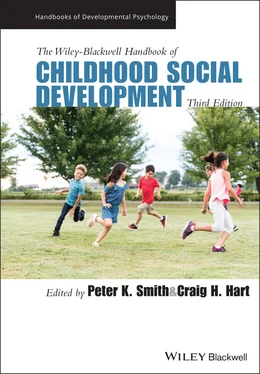Concerns about human effects on the global climate, sometimes referred to as global warming but more generally inducing climate instability, has been increasing over decades but has reached a new level of urgency in recent years, as in the 2015 Paris Agreement. Ann Sanson, Karina V. Padilla Malca, and Judith Van Hoorn overview what we know about the impact of the climate crisis on children’s social development. Severe climate changes can of course lead to famine and conflicts, as described in Chapter 10. Besides the direct effects and via caregivers, these can impact on schooling and social networks. These can especially impact on girls, and on minority groups. The authors discuss research on what children know about climate change, their feelings about it, and how they try to cope with this. This chapter too concludes with practical implications of the research, including building children’s capacity to cope, promoting love of nature, understanding of climate change, and encouraging self‐efficacy, collective efficacy and agency (as for example in the school strike protests organized by children and young people themselves).
Finally in this Part, Rashmita S. Mistry, Aprile D. Benner, and Anna M. Kimura consider the impact of the Covid‐19 pandemic on children’s social development. Appearing first at the very end of 2019, this pandemic has had a huge impact on countries across the globe, causing severe illnesses and many deaths, and huge economic disruption through lockdowns of varying length and severity, in attempts to stem transmission. Although vaccination procedures hold out hope of subduing this virus, at the time of writing this is far from accomplished. As the authors point out, although children generally appear less susceptible to direct adverse effects of Covid‐19, they are greatly affected by changes in family circumstances (deaths, financial stability) and schooling. There are also increases in racial attacks and hate incidents, for example against Asian minorities. In assessing the impact of Covid‐19, the authors use Elder’s life course theory as an explanatory framework. This highlights for example the developmental stage that children are at, at the time of the pandemic, in terms of impact on parents, family conditions, and peer networks especially at school. This area of research is growing rapidly, and besides providing important insights, may result in useful practical suggestions for ameliorating the negative effects, and making most use of alternative means of sustaining relationships through social networking and other virtual means.
CHAPTER EIGHT Ecological Perspectives and Social Development
Rachel Maunder
This chapter will introduce the central components of ecological perspectives, and how they can be used to understand children’s social development. The roots of ecological approaches will be examined, along with some key perspectives that frequent literature in the field. Two areas of social development (parenting and attachment, and bullying) will be used to demonstrate how ecological positions can be applied. Implications for both research and intervention will be explored, along with challenges in the field.
Introduction to Ecological Perspectives
The term “ecology” refers to a branch of science where organisms are studied in relation to their environment. Organisms interact with their physical surroundings and other living things creating a dynamic ecosystem, and the growth and sustainability of living things are maintained by their participation in these relational systems (Heft, 2013). Although ecology stems from biology, the term and its meaning are used and applied across various disciplines.
Within psychology, the role of the environment may be acknowledged to varying degrees, but historically psychology has been dominated by approaches that dichotomize person and environment and apply experimental techniques seeking to control contextual variables and reduce the “noise” created by external factors (Tudge et al., 1996). Therefore, ecological psychology was initially marginalized, and some of the early work only came to fruition long after it was originally published (Heft, 2013). Contemporary psychology now sees a more prominent place for ecological perspectives. The following sections will take a closer look at ecological perspectives in psychology and examine some of the underlying principles that they have in common.
Gibson’s (1979a) work on perception is often presented as the beginning of ecological psychology. He argued that perception could only be understood in relation to both the perceiver and the perceived. The environment that a living organism inhabits presents some possibilities and restricts others. An example might be the climate where an animal lives and the type of land. The organism also plays a part in influencing their habitats, for example by eating crops and building shelters. The environment offers an array of opportunities or “affordances” to organisms for how they can live in it (Gibson, 1979b). An organism’s characteristics will impact on which affordances are appropriate. For example, a tree can be used for climbing, eating, living in, or building with depending on the organism. The organism is also active in relation to affordances. For example, the potential of a tree to be used for building is only realized when it is felled and cut into pieces of wood. There is, therefore, an ongoing and reciprocal relationship between the organism and its surroundings. The organism both impacts on and is impacted by its environment.
Gibson saw perception and action as a reciprocal cycle, whereby what someone perceives influences their actions, and their actions impact on the way they perceive. Although Gibson’s theory was specifically about visual perception, the key premise of his ideas can inform our understanding of human development from an ecological perspective. He saw perception as an active process, shaped by characteristics of the environment, characteristics of the person, and relations with others. Therefore, the relationship between living things and their environments is mutual and reciprocal.
Bronfenbrenner’s ecological system
Bronfenbrenner’s ecological system is probably the most widely applied ecological perspective in psychology. The core features are the role of context in human development, and the interaction between person and environment.
Bronfenbrenner conceptualized the environment or “ecological system” as nested structures like a set of Russian dolls (Bronfenbrenner, 1979, p. 3). The concentric circles or tiers of the ecological system represent the settings within which an individual is embedded, and which mutually shape their development. The person is at the center, and each system operates around them in a hierarchy, with those settings that they have most direct contact being closest and those that have a more distal relationship to their functioning positioned further away. Each layer is contained within the other, and each has an influence on the other structures, and on the person.
At the center of the ecological system is the growing child with their personal attributes – known as “ developmentally instigative characteristics ” (Bronfenbrenner, 1993). These characteristics comprise of dispositions (such as temperament, motivation, genes, biological features), resources (such as abilities, knowledge, skills) and demand characteristics (such as age, gender, appearance) (Bronfenbrenner & Morris, 2006). An individual’s personal attributes shape the way others behave towards them and sets in motion certain events or interactions in their environment.
The microsystemis the closest ecological system to the child and reflects the settings they interact with most often and most intensively. The home, family, peer group, and school would be examples, and the nature and quality of the relationships a child has with these contexts will have a direct impact on their daily life. For example, a child raised in a supportive and nurturing family will have a different experience to a child brought up in a volatile unstable one. In addition, how a child interacts with their microsystem will have an influence. A child who reacts to peers at school with friendliness and humor will likely have different relationships to a child who is conflictual or sullen. These examples show how a person’s characteristics can invite or discourage responses from the environment, and promote or discourage growth (Bronfenbrenner, 1989).
Читать дальше












